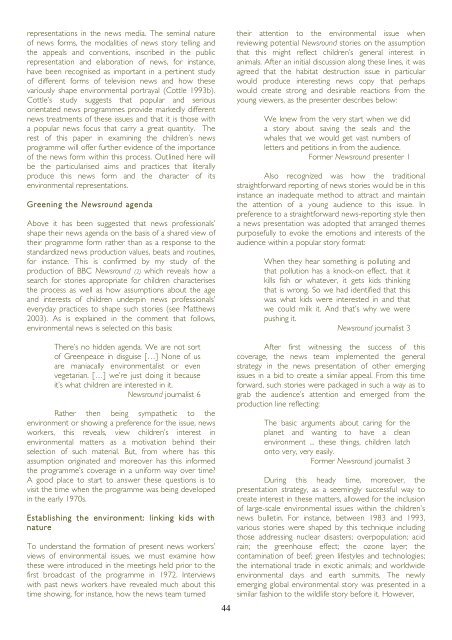M - Antennae The Journal of Nature in Visual Culture
M - Antennae The Journal of Nature in Visual Culture
M - Antennae The Journal of Nature in Visual Culture
You also want an ePaper? Increase the reach of your titles
YUMPU automatically turns print PDFs into web optimized ePapers that Google loves.
epresentations <strong>in</strong> the news media. <strong>The</strong> sem<strong>in</strong>al nature<br />
<strong>of</strong> news forms, the modalities <strong>of</strong> news story tell<strong>in</strong>g and<br />
the appeals and conventions, <strong>in</strong>scribed <strong>in</strong> the public<br />
representation and elaboration <strong>of</strong> news, for <strong>in</strong>stance,<br />
have been recognised as important <strong>in</strong> a pert<strong>in</strong>ent study<br />
<strong>of</strong> different forms <strong>of</strong> television news and how these<br />
variously shape environmental portrayal (Cottle 1993b).<br />
Cottle’s study suggests that popular and serious<br />
orientated news programmes provide markedly different<br />
news treatments <strong>of</strong> these issues and that it is those with<br />
a popular news focus that carry a great quantity. <strong>The</strong><br />
rest <strong>of</strong> this paper <strong>in</strong> exam<strong>in</strong><strong>in</strong>g the children’s news<br />
programme will <strong>of</strong>fer further evidence <strong>of</strong> the importance<br />
<strong>of</strong> the news form with<strong>in</strong> this process. Outl<strong>in</strong>ed here will<br />
be the particularised aims and practices that literally<br />
produce this news form and the character <strong>of</strong> its<br />
environmental representations.<br />
Green<strong>in</strong>g the Newsround agenda<br />
Above it has been suggested that news pr<strong>of</strong>essionals’<br />
shape their news agenda on the basis <strong>of</strong> a shared view <strong>of</strong><br />
their programme form rather than as a response to the<br />
standardized news production values, beats and rout<strong>in</strong>es,<br />
for <strong>in</strong>stance. This is confirmed by my study <strong>of</strong> the<br />
production <strong>of</strong> BBC Newsround (2) which reveals how a<br />
search for stories appropriate for children characterises<br />
the process as well as how assumptions about the age<br />
and <strong>in</strong>terests <strong>of</strong> children underp<strong>in</strong> news pr<strong>of</strong>essionals’<br />
everyday practices to shape such stories (see Matthews<br />
2003). As is expla<strong>in</strong>ed <strong>in</strong> the comment that follows,<br />
environmental news is selected on this basis:<br />
<strong>The</strong>re’s no hidden agenda. We are not sort<br />
<strong>of</strong> Greenpeace <strong>in</strong> disguise […] None <strong>of</strong> us<br />
are maniacally environmentalist or even<br />
vegetarian. […] we’re just do<strong>in</strong>g it because<br />
it’s what children are <strong>in</strong>terested <strong>in</strong> it.<br />
Newsround journalist 6<br />
Rather then be<strong>in</strong>g sympathetic to the<br />
environment or show<strong>in</strong>g a preference for the issue, news<br />
workers, this reveals, view children’s <strong>in</strong>terest <strong>in</strong><br />
environmental matters as a motivation beh<strong>in</strong>d their<br />
selection <strong>of</strong> such material. But, from where has this<br />
assumption orig<strong>in</strong>ated and moreover has this <strong>in</strong>formed<br />
the programme’s coverage <strong>in</strong> a uniform way over time?<br />
A good place to start to answer these questions is to<br />
visit the time when the programme was be<strong>in</strong>g developed<br />
<strong>in</strong> the early 1970s.<br />
Establish<strong>in</strong>g the environment: l<strong>in</strong>k<strong>in</strong>g kids with<br />
nature<br />
To understand the formation <strong>of</strong> present news workers’<br />
views <strong>of</strong> environmental issues, we must exam<strong>in</strong>e how<br />
these were <strong>in</strong>troduced <strong>in</strong> the meet<strong>in</strong>gs held prior to the<br />
first broadcast <strong>of</strong> the programme <strong>in</strong> 1972. Interviews<br />
with past news workers have revealed much about this<br />
time show<strong>in</strong>g, for <strong>in</strong>stance, how the news team turned<br />
44<br />
their attention to the environmental issue when<br />
review<strong>in</strong>g potential Newsround stories on the assumption<br />
that this might reflect children’s general <strong>in</strong>terest <strong>in</strong><br />
animals. After an <strong>in</strong>itial discussion along these l<strong>in</strong>es, it was<br />
agreed that the habitat destruction issue <strong>in</strong> particular<br />
would produce <strong>in</strong>terest<strong>in</strong>g news copy that perhaps<br />
would create strong and desirable reactions from the<br />
young viewers, as the presenter describes below:<br />
We knew from the very start when we did<br />
a story about sav<strong>in</strong>g the seals and the<br />
whales that we would get vast numbers <strong>of</strong><br />
letters and petitions <strong>in</strong> from the audience.<br />
Former Newsround presenter 1<br />
Also recognized was how the traditional<br />
straightforward report<strong>in</strong>g <strong>of</strong> news stories would be <strong>in</strong> this<br />
<strong>in</strong>stance an <strong>in</strong>adequate method to attract and ma<strong>in</strong>ta<strong>in</strong><br />
the attention <strong>of</strong> a young audience to this issue. In<br />
preference to a straightforward news-report<strong>in</strong>g style then<br />
a news presentation was adopted that arranged themes<br />
purposefully to evoke the emotions and <strong>in</strong>terests <strong>of</strong> the<br />
audience with<strong>in</strong> a popular story format:<br />
When they hear someth<strong>in</strong>g is pollut<strong>in</strong>g and<br />
that pollution has a knock-on effect, that it<br />
kills fish or whatever, it gets kids th<strong>in</strong>k<strong>in</strong>g<br />
that is wrong. So we had identified that this<br />
was what kids were <strong>in</strong>terested <strong>in</strong> and that<br />
we could milk it. And that’s why we were<br />
push<strong>in</strong>g it.<br />
Newsround journalist 3<br />
After first witness<strong>in</strong>g the success <strong>of</strong> this<br />
coverage, the news team implemented the general<br />
strategy <strong>in</strong> the news presentation <strong>of</strong> other emerg<strong>in</strong>g<br />
issues <strong>in</strong> a bid to create a similar appeal. From this time<br />
forward, such stories were packaged <strong>in</strong> such a way as to<br />
grab the audience’s attention and emerged from the<br />
production l<strong>in</strong>e reflect<strong>in</strong>g:<br />
<strong>The</strong> basic arguments about car<strong>in</strong>g for the<br />
planet and want<strong>in</strong>g to have a clean<br />
environment ... these th<strong>in</strong>gs, children latch<br />
onto very, very easily.<br />
Former Newsround journalist 3<br />
Dur<strong>in</strong>g this heady time, moreover, the<br />
presentation strategy, as a seem<strong>in</strong>gly successful way to<br />
create <strong>in</strong>terest <strong>in</strong> these matters, allowed for the <strong>in</strong>clusion<br />
<strong>of</strong> large-scale environmental issues with<strong>in</strong> the children’s<br />
news bullet<strong>in</strong>. For <strong>in</strong>stance, between 1983 and 1993,<br />
various stories were shaped by this technique <strong>in</strong>clud<strong>in</strong>g<br />
those address<strong>in</strong>g nuclear disasters; overpopulation; acid<br />
ra<strong>in</strong>; the greenhouse effect; the ozone layer; the<br />
contam<strong>in</strong>ation <strong>of</strong> beef; green lifestyles and technologies;<br />
the <strong>in</strong>ternational trade <strong>in</strong> exotic animals; and worldwide<br />
environmental days and earth summits. <strong>The</strong> newly<br />
emerg<strong>in</strong>g global environmental story was presented <strong>in</strong> a<br />
similar fashion to the wildlife story before it. However,












